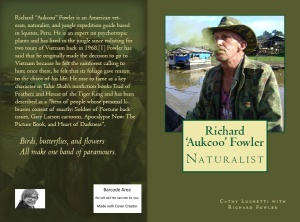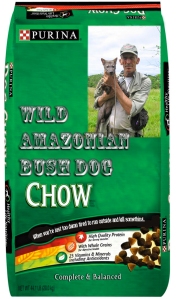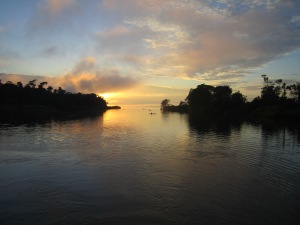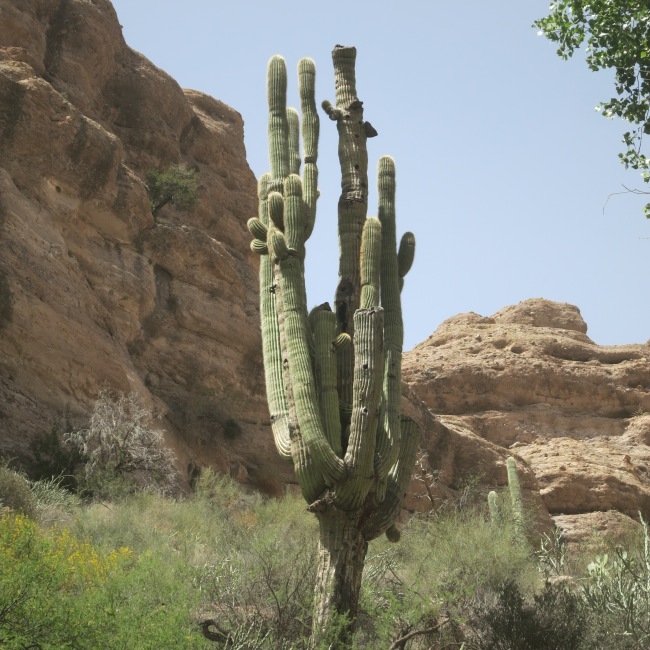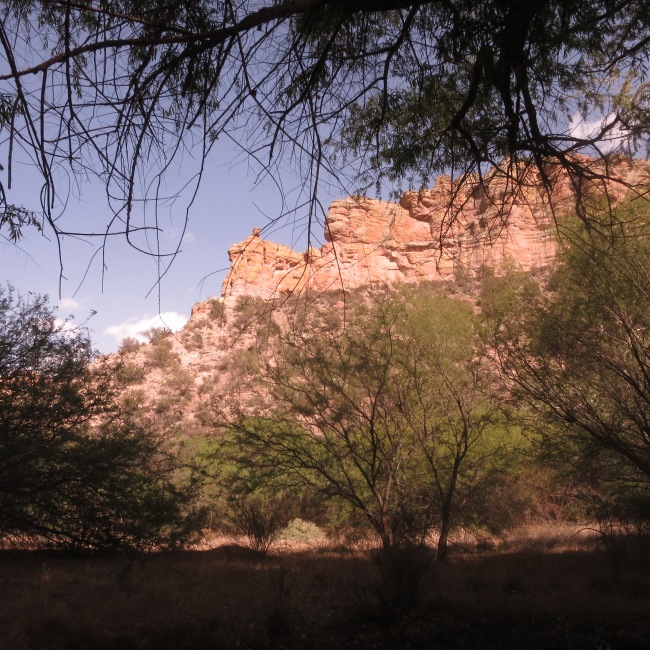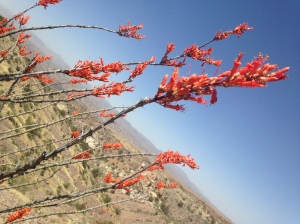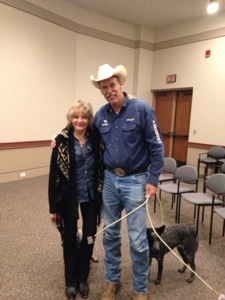Aukcoo gives an insight into the jungle, his adventure world, his life in the Amazon as a naturalist, guide, and folk anthropologist. As he writes, “Curare, also known as Ampi, can kill or cure. Indigenous people in all tropical regions of the world can make effective arrow and dart poisons from hundreds of varieties of plants, as well as animal and insect toxins. I have studied some of these compounds and they are very lethal. Here in the Amazon we have such a bounty of plants so rich in alkaloids that an effective survival curare can be made by boiling down several kilos of any combination of 20 different species (known and unknown species) of jungle leaves. Once it becomes a thick syrupy tar it will most likely be to bring down anything from a monkey to man. I call this “Martha Stewart Curare.”
Author Archives: CathyLuchetti
An Amazon Trek with Auckoo to find the elusive Amazonian bush dog
When Auckoo asked me to “write his book” it was too good to pass up. Whether biography or autobiography, this is a story that must be told. A story of wilderness survival, a man of the jungle, a man married to a Jivaro Indian in Peru, her tribe once being headhunters. He knows every path, every secret place, where to find frogs for sapo, where to track the elusive bush dog. I’ll interview and write for a week and then trek into the jungle to find the dog. Thanks to Beverly, there’s now a dandy graphic of Auckoo – who knows, perhaps this will be the cover? “Bring 12 fox traps, a bottle of jack daniels, cigars and Red Wing boots” he said. The traps are suited with special foam to prevent any discomfort. That is, if a dog happens to come along. Also will take snake gaiters.
Back to Iquitos
Wilderness Research
Whaaa?
The bear bags swing overhead like a sprung metronome. We watch dinner circle idly through the air, the loop designed to unravel when pulled now snarled as a 5 o’clock freeway. No amount of poking it with a stick can wiggle them free.
The Gila Wilderness in New Mexico does not forgive errors. It’s where Caballo Blanco, or White Horse, the legendary figure from the Copper Canyon, died several years ago. Out running, he bent to tie his shoe and simply passed away. It’s where javalina frisk, rattlers unwind, and the world’s most alluring hot spring laps crystal blue water at mossy banks. We’ve hiked 6 miles uphill to find Jordan Hot Springs, an oasis in this 438,000 tract of deep canons at the edge of the Chihuahuan desert. It’s here amidst towering agave, saguaro and pine that Geronimo claimed his birth, and where Apaches warriors holed up between attack raids.
Tired, hungry and played out, we’ve hiked all day, straight up the mountain behind the springs, scrambling up and down a slope so steep that hands, knuckles and knees are bruised. Kenneth nearly bumped heads with a grandfather rattler, its snout the size of his fist, cold eyes only inches from his own. In fact, every foot of mountain harbors shadowy rock snake condos, ideal alcoves for the toxic Mojave Green and its aggressive cousin , the diamondback. Rattler sightings continue daily for the next week. We are jumpy, disoriented, and now hungry.
The bags swing, elusive. We’d promised the Viking a drink of Courvoisier, but no such luck. The bottle hangs from the tree along with our dried food, tempting but out of reach. The Viking is a stocky, bearded Iraqi vet, part of a group of Vet “Warriors” marching the CDT toward their destination of Pie Town. “Pie!” they chant, “pie!” They hike alone, and after the Viking left, each would query anxiously how far ahead the Viking was, challenged to catch up.
The Viking stands, hands on hips. He watches the bag furl overhead, bulging with food and drink. He mentally scrolls through possible military applications until he finds one that will work. It involves a log tied to a rope and thrown up over the tree limb, snaring the limb, the ropes, and the food bags. With a flex of Viking muscles he gives a huge bear tug and pulls everything down, ropes, limbs, leaves, and bags. Out comes Kim’s bottle. The Viking takes a suck and is on his way.
Next stop, the remote Aravaipa Canyon in Arizona. Aravaipa is either Apache, Pima or Papago for “little wells” or “laughing waters,” both of which abound. The gorge lies southeast of Phoenix and northeast of Tucson in the Pinal Mountains, an eleven-mile paradise little known outside Arizona.
Civilization falls away as the truck bumps along a dusty road spiked with blooming ocotillo, sliding through running streams to arrive at the trailhead.
Before us simmers one of the Southwest’s most amazing desert canyons, an Eden of twisted walls of andesite and tuff, shaded by cottonwood umbrellas, cut through by giant slices of canyon over 1000 ft. deep in the Galiuro Mountains. The perennial creek looks shy and mild, hardly the same raging tyrant that flung riprap and logs—sycamore, willow, salt cedar, alder, desert hackberry and a kind of wild walnut as long as a house–onto the sandy banks during flood time. Before us lie springs, seeps, and streams, rimmed by vegetation so lush, so pushy, it’s almost audible. This is allergy country, but the seedy herbaceous plants, so tangled you have to kick them to get through, have other uses. Many are edible, some medicinal, and a few dangerously toxic. Sturdy poison hemlock from the carrot family shoots high, its small flowers inviting, the same ones ingested by Socrates as he sought death. Grass waves, ferns dangle, toad rush and Arizona mousetail rattle in the breeze. Mousetail is reputed to be used by the Navajo as an aid for ant bites, or to facilitate swallowing ants. In fact, an ant digestife!
Trailside, the Sonoran maiden fern sprouts from slick, wet canyon seeps, and in scouting for native headache herbs for my book, “Travels with My Headache” I find bouquets of chicorea, or dandelion, its fresh leaves or dried roots brewed into tea for a laxative or for frontal headaches. Headache relief also comes from Cardo Santo, or thistle poppy, used as a tea or applied externally. Perhaps at night we can boil up the leaves of the silver sage and inhale the steam as a headache cure, or simply chomp on the lush green poleo, or pennyroyal mint. Poleo, writes ethno botanist Michael Moore, cures feverish headaches. Also useful for headaches is willow bark, boiled and drunk.
Red penstemons, desert marigolds, strawberry cacti and a carpet of jaunty flowers sprout underfoot, or hang like Babalyon down vertical canyon walls. Above the stream thrive teddy bear cholla, agaves, jojoba, mesquite, barrel cactus, hedgehog cactus, and clockface prickly pear, each slowly, slowly, evolving uphill.
Frolicking through the herbal pharmacopeia is scat and print evidence of javalina, mountain lions, deer, mountain sheep, black bears, and, unbelievably, coati mundi, last seen in Costa Rica but now at home in Arizona, their huge ringed tails dragging along the canyon ledges in a playground as lush as any jungle. A rainbow of 200 birds warble at dawn, waking up their larger neighbors, blue herons, hawks, and turkey vultures.
“Rattlers!” Other hikers told us. “Rattlers everywhere.”
They slither from trailside, one letting out a hiss at Don instead of the customary rattle. Drawn to the warm trails in the afternoon sun, we crisscross paths with them in the afternoon. One adolescent the length of my arm, yellow scales amid yellow leaves, glides near my tent with its rattle lifted high. It sees me, flinches into strike mode and rattles like brittlebush. Finally it sleeks back to its route, but so slowly as to seem, in teenager fashion, deliberate. After half an hour, it’s only gone a few feet, finally curling up under a log at the campfire. A few pokes with a long stick and it strikes, curls, strikes again, then curls into a tight pyramid, tail wagging. More pokes, but it only fights back. We flip it a few feet and it sizzles back at us. Finally all we can do is leave it alone, hoping that it will slide out of camp. Flint eyes glaring, it finally slithers away, but oh, so slowly.
For me, the adventure of a wilderness backpack is not only the physical strain, but tracing plants and their uses through time. To camp near a leathery green jojoba and recognize it as the origin of the jojoba oil I use at night. And that this oil was used by Southwestern Indians for shampoo, and the plant’s roasted beans for coffee, and its raw green seeds to relieve a sore throat, is a marvel. Here, every plant has a story, a history, and a use.
Aravaipa Canyon Wilderness
A three-day Backpack into the Aravaipa Canyon, Arizona’s version of Eden. Over 200 bird species, all singing in unison at dawn, lovely! Javalina, rattlers, coatimundi, ringtail cars, desert bighorn, black bears, mountain lions plus herbs, trees, and greenery flowering in the Sonoran desert. 11-miles of the most lush, surprising wilderness I’ve ever seen.
Longview Texas author’s event
Thanks to everyone in Texas, especially Victoria Wilson, who initiated this event. There were 20 authors from east Texas, and myself. “Are you from Texas?” they all asked. I said “yes” because that’s how I feel. No matter how many years have passed.
Meeting Skidboot’s owner, David Hartwig
After 6 months of phone interviews meeting the real David was a long awaited pleasure.
He has three new “Skidboot’s” one of which will star in the movie. Now in pre production…..
Celebrate Authors Event in Longview Texas
Skidboot Goes to Times Square

Wish I’d been there to look up and see Skidboot joyfully presiding over New York City. The hero of the Skidboot book–Skidboot–made many appearances there.
Skidboot goes public
A new wire release has been picked up around the country – go Skidboot!

